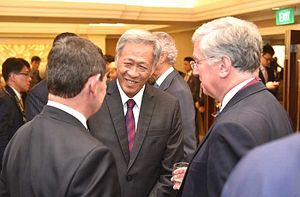There was no shortage of topics under discussion by delegates last weekend at the 2018 iteration of the Shangri-La Dialogue (SLD), Asia’s premier security summit, in Singapore. But as it did last year, the SLD this year provided an opportunity for those present to hear from host nation Singapore, which is also holding the annually rotating ASEAN chairmanship this year, about where some of the key defense initiatives are today for the regional grouping.
Though ASEAN priorities generally tend to evolve over several chairmanships and need to be approved by the grouping as a whole, the holder of the ASEAN chair does usually try to advance several key initiatives during its tenure as well that can either be completed during the year or taken forward by its successor.
In Singapore’s case, as I have noted previously, last year’s SLD as well as during subsequent addresses in 2018, including at the ASEAN Defense Ministers’ Meeting (ADMM) Retreat earlier this year, Defense Minister Ng Eng Hen and other officials had laid out some of the city-state’s key agenda items, including on counterterrorism, managing chemical, biological, and radioactive threats, as well as confidence-building measures (CBMs) (See: “Singapore Unveils New ASEAN Defense Initiatives Ahead of Chairmanship”).
At this year’s SLD, Ng offered an update as to some of these key initiatives. Perhaps of greatest interest to delegates present was the holding of an ASEAN-China Maritime Exercise. As I have observed previously, though the idea of such an exercise dates back several years to when China first proposed it to Southeast Asian states, the fact that it has gained momentum is reflective of recent developments underway in the region, including in the South China Sea (See: “What’s Behind the New China-ASEAN Maritime Exercise?”).
As of now, it looks like the exercise is set to take place as originally intended. As an update, Ng said that all Southeast Asian countries had agreed to participate and send ships or troops to the exercise, and that Singapore, as ASEAN chair, would be co-directors with China for the exercise and will host the table-top exercise in Singapore in August. Though we will have to await more details and the holding of the engagement itself to fully assess it, the fact that it is occurring at all is itself significant.
Another agenda item of interest, also within the broad notion of confidence-building measures, is the idea of guidelines for air encounters between military aircraft. This, too, is part of a broader discussion about such CBMs in recent years, from the greater adoption and operationalization of the Code for Unplanned Encounters at Sea (CUES) adopted by the ADMM-Plus navies last year to a discussion of how such measures would work in the undersea domain which Singapore has also been promoting.
With respect to guidelines for air encounters, Ng said Singapore hoped to adopt these at the 12th iteration of the ADMM in October, before it is expanded to the ADMM-Plus. If this proceeds as planned, that would no doubt be significant as it would constitute the first multilateral implementation of confidence-building measures in this realm in the world.
A final area where Ng provided an update on was in that of counterterrorism. Here, we have seen a whole range of measures advanced at various levels, including bilaterally among Southeast Asian states as well as subregionally between them as well as with external partners. Singapore has been involved in some of these but has also made this a priority for its ASEAN chairmanship as well, proposing a framework of “resilience, response, and recovery” and also drawing attention to the nexus between terrorist groups and rogue actors and chemical, biological, and radioactive weapons (CBR).
As part of that wider framework, Ng said at the SLD that Singapore would host a Track 1.5 counterterrorism symposium that would be held in October this year during its chairmanship. In addition, elaborating on an idea that has been previously mulled, Ng said the ADMM was in the process of building what he had characterized before as a virtual ASEAN network of CBR defense experts. The idea would be to deepen links among ASEAN experts in this area and increase the pool of capabilities to reach out to in the event of a disaster where quick collective response would no doubt be key.
We will hear much more in the way of specifics with respect to each of these initiatives as Singapore’s ASEAN chairmanship progresses through the rest of 2018. But there is little doubt that the city-state’s leadership of the regional grouping this year has not been short on action on the defense side.

































